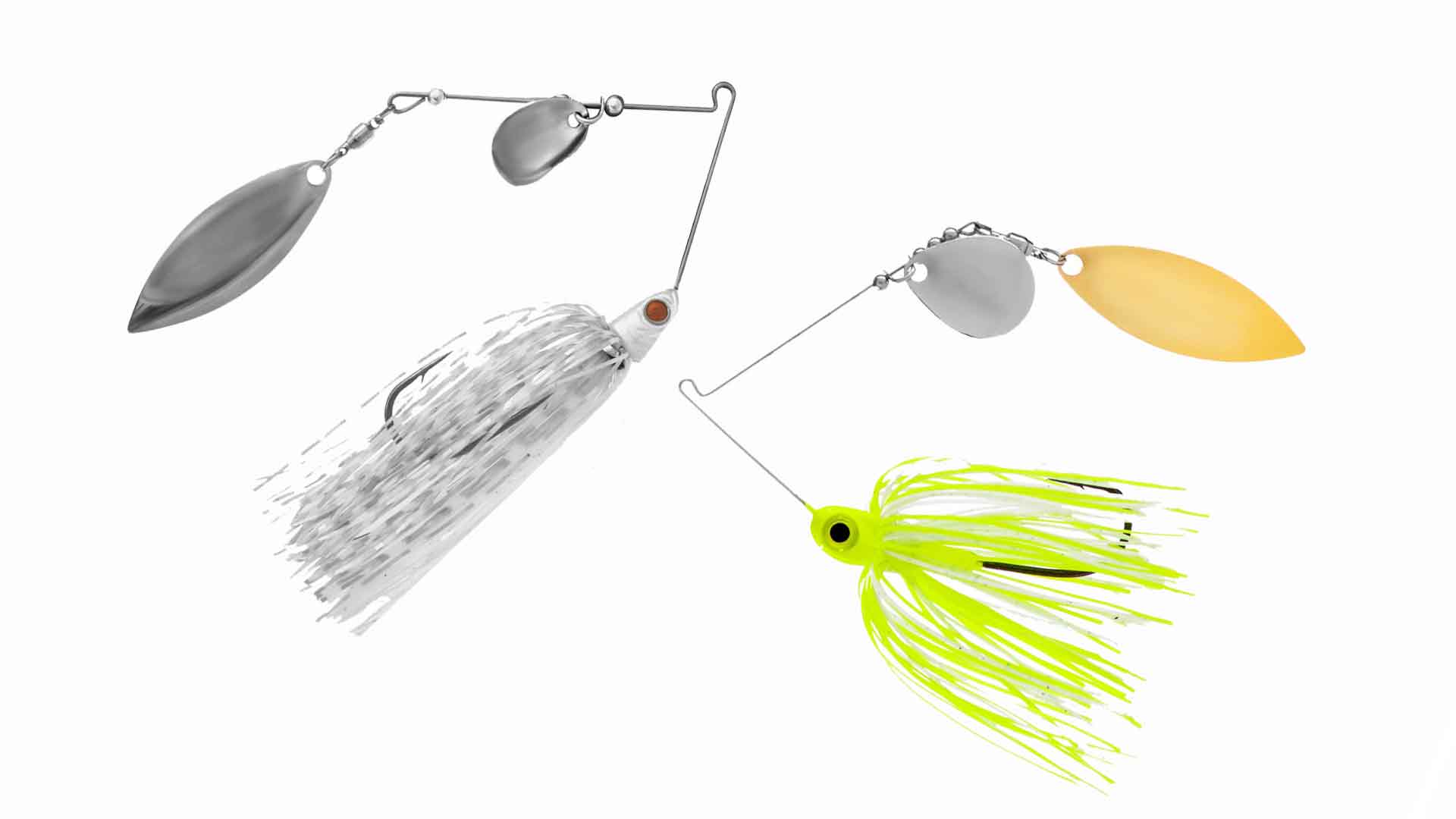Spinnerbaits are a key component in the tackle boxes of anglers worldwide, known for their unique ability to attract a wide variety of fish species. These lures, characterized by their spinning metal blades, create visual flashes and vibrations in the water that mimic the movements of distressed baitfish, making them highly attractive to predators. This guide explores the various types of spinnerbaits, their optimal uses, and advanced techniques, providing insights that cater to both novice anglers and experienced professionals.
The Mechanics of Spinnerbaits
Spinnerbaits are designed with a distinct structure that includes a wire arm, a weighted head, a hook, and a skirt, usually made of silicone or other soft materials. The spinning blades are attached to the wire arm and rotate as the lure is retrieved through the water. This rotation generates vibrations and flashes, which can mimic the erratic movements of small, injured fish—a signal that often triggers predatory instincts in species such as bass, pike, and muskie.
Studies from fisheries biologists have shown that the combination of light reflection and vibration created by spinnerbaits can be particularly effective in attracting fish. The blades’ movement not only draws attention through visual cues but also through the vibrations detected by the fish’s lateral line—a sensory organ that helps fish sense movement and vibrations in the water.
Types of Spinnerbaits: A Comprehensive Guide
Spinnerbaits are not uniform; they come in different designs, each suited for specific fishing environments and target species:
Willow Blade Spinnerbaits: These lures are equipped with long, narrow blades that spin rapidly, producing minimal drag and a subtle, high-speed flash. They are particularly effective in clear water conditions where fish rely heavily on visual cues. The rapid, tight rotation of the willow blades mimics the movement of small, quick baitfish, which can be especially enticing to fast-moving predatory fish. Professional angler Bill Dance often recommends willow blade spinnerbaits for targeting bass in open water, where the clear visibility allows the subtle flash to attract attention from afar.
Colorado Blade Spinnerbaits: Known for their broad, rounded blades, Colorado spinnerbaits produce strong vibrations and a pronounced thumping sound underwater. These features make them ideal for murky or stained water conditions, where visibility is limited. The vibrations can travel farther through the water, helping fish locate the lure even when they can’t see it clearly. This makes Colorado blades particularly useful for night fishing or in overcast weather conditions. Anglers like Kevin VanDam often use Colorado blade spinnerbaits to exploit the fish’s lateral line, which can detect these strong vibrations.
Indiana Blade Spinnerbaits: As a middle ground between willow and Colorado blades, Indiana blades offer a balanced mix of flash and vibration. This versatility allows them to be used in a range of conditions, from clear to moderately stained waters. Indiana blade spinnerbaits are particularly effective in environments where a moderate amount of vibration is needed to attract fish without overwhelming them. Gary Klein, a seasoned angler, often uses Indiana blades in rivers and streams where the water clarity can vary significantly.
Strategic Use of Spinnerbaits: Timing and Location
The success of using spinnerbaits can depend heavily on the timing and location of their use:
- Seasonal Dynamics: Spinnerbaits are especially effective during the transitional periods of spring and fall. In spring, fish often move into shallow waters to spawn, becoming highly territorial and aggressive. This makes spinnerbaits an excellent choice for covering these areas, as their design can provoke reaction strikes from protective fish. In the fall, fish tend to feed more aggressively to prepare for winter, and spinnerbaits can be used to mimic the schooling baitfish that they prey upon. The increased activity of fish during these times makes spinnerbaits particularly effective.
- Water Clarity: The clarity of the water can significantly influence the choice of spinnerbait blades. In clear water, where fish are more visually oriented, willow blades are effective due to their subtle flash. In murky or stained water, Colorado blades, with their strong vibration, are more suitable as they provide auditory cues that can attract fish. The color of the skirt and blades should also be considered, with natural hues working best in clear water and brighter, more contrasting colors being more effective in low-visibility conditions.
- Structure and Cover: Spinnerbaits are highly effective around structures such as submerged logs, rocks, and vegetation. These environments provide cover for prey fish, making them prime hunting grounds for predators. The design of spinnerbaits allows them to be fished close to these structures with minimal risk of snagging. The skirt and blades can imitate a baitfish hiding among the cover, making the lure irresistible to ambush predators. This ability to fish around structures effectively makes spinnerbaits a versatile tool in various fishing scenarios.
Advanced Spinnerbait Techniques for Increased Success
Mastering spinnerbait fishing involves more than just casting and retrieving; it requires understanding and implementing advanced techniques:
- The Steady Retrieve: This basic technique involves reeling in the spinnerbait at a consistent speed. It’s particularly effective in clear waters where fish can track the lure visually. The steady retrieve keeps the lure at a consistent depth and allows the blades to spin continuously, providing a steady flash and vibration. This method is useful for covering large areas and locating active fish, especially when combined with occasional pauses to mimic the erratic movement of a fleeing baitfish.
- The Stop-and-Go: This technique involves pausing the retrieve intermittently, allowing the spinnerbait to flutter down like a wounded or dying baitfish. The sudden change in motion can trigger predatory fish to strike, especially in clear water where the visual aspect of the lure’s movement is key. The stop-and-go technique is particularly useful for targeting fish that are less aggressive or are in a neutral feeding mood, as the erratic movement can provoke a reaction strike.
- The Slow Roll: Slow rolling involves retrieving the spinnerbait slowly along the bottom, making it an ideal strategy for cold water or deep fishing scenarios. This technique keeps the lure in the strike zone longer, allowing it to move slowly enough to attract lethargic fish. Slow rolling is especially effective in the early spring or late fall when water temperatures are cooler and fish are less active. The slow, deliberate movement of the spinnerbait can mimic the behavior of bottom-dwelling prey, making it an attractive option for species like bass and walleye.
Selecting the Right Spinnerbait: Key Considerations
Choosing the appropriate spinnerbait requires consideration of several factors, including the target species, environmental conditions, and the angler’s specific goals:
- Blade Type: The choice between willow, Colorado, and Indiana blades should be based on water clarity and the desired action. Willow blades offer a fast, tight flash that is ideal for clear water conditions. Colorado blades, with their pronounced thump and vibration, are better suited for murky waters where fish rely more on their lateral line to detect prey. Indiana blades provide a balance of flash and vibration, making them versatile for a range of conditions.
- Size: The size of the spinnerbait should match the size of the baitfish in the area and the target species. Larger spinnerbaits are typically used for targeting larger fish, while smaller spinnerbaits can appeal to a broader range of species. The size of the spinnerbait also affects its action, with larger lures producing a more pronounced wobble and smaller lures offering a tighter, more subtle action.
- Color: The color of the spinnerbait is a crucial factor in its effectiveness. In clear water, natural colors such as silver, white, or shad patterns are effective because they closely resemble the local forage. In murky water, bright colors like chartreuse, orange, or fire tiger are more visible and can attract fish from a distance. The color choice should also consider the time of day and light conditions, as different colors can become more visible under varying lighting.
Maintaining Your Spinnerbaits
Proper maintenance of spinnerbaits is crucial for ensuring their longevity and performance. After each use, especially if the spinnerbaits have been used in saltwater, it’s important to rinse them with freshwater to remove any salt, debris, or residue that could cause corrosion. Regularly inspecting the blades and skirt for damage is also essential, as any wear and tear can diminish the lure’s effectiveness. Replacing damaged components promptly ensures that the spinnerbait remains in optimal condition and continues to perform well in the water.
Conclusion: The Essential Role of Spinnerbaits
Spinnerbaits are a versatile and indispensable tool for any angler, offering unparalleled versatility and effectiveness across various fishing scenarios. Whether you’re a beginner eager to expand your lure collection or an experienced angler looking to refine your techniques, understanding the nuances of spinnerbaits can lead to more successful and enjoyable fishing experiences. The key to mastering spinnerbaits lies in experimenting with different types, techniques, and conditions to discover what works best for you.
At BaitBeast, we believe that spinnerbaits are more than just a lure—they are a strategic asset that, when used correctly, can significantly enhance your fishing adventures. Equip yourself with the knowledge and tools provided in this guide, and get ready to “Release the Beast” on your next fishing trip with BaitBeast’s premium selection of spinnerbaits.


 baitbeast.com
baitbeast.com
Thank you for making this post easy to understand and well-explained for beginner anglers.